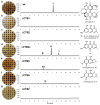Molecular Characterization of the Cercosporin Biosynthetic Pathway in the Fungal Plant Pathogen Cercospora nicotianae
- PMID: 26938470
- PMCID: PMC5129747
- DOI: 10.1021/jacs.6b00633
Molecular Characterization of the Cercosporin Biosynthetic Pathway in the Fungal Plant Pathogen Cercospora nicotianae
Abstract
Perylenequinones are a class of photoactivated polyketide mycotoxins produced by fungal plant pathogens that notably produce reactive oxygen species with visible light. The best-studied perylenequinone is cercosporin-a product of the Cercospora species. While the cercosporin biosynthetic gene cluster has been described in the tobacco pathogen Cercospora nicotianae, little is known of the metabolite's biosynthesis. Furthermore, in vitro investigations of the polyketide synthase central to cercosporin biosynthesis identified the naphthopyrone nor-toralactone as its direct product-an observation in conflict with published biosynthetic proposals. Here, we present an alternative biosynthetic pathway to cercosporin based on metabolites characterized from a series of biosynthetic gene knockouts. We show that nor-toralactone is the key polyketide intermediate and the substrate for the unusual didomain protein CTB3. We demonstrate the unique oxidative cleavage activity of the CTB3 monooxygenase domain in vitro. These data advance our understanding of perylenequinone biosynthesis and expand the biochemical repertoire of flavin-dependent monooxygenases.
Figures








Similar articles
-
The Cercospora nicotianae gene encoding dual O-methyltransferase and FAD-dependent monooxygenase domains mediates cercosporin toxin biosynthesis.Fungal Genet Biol. 2007 May;44(5):444-54. doi: 10.1016/j.fgb.2006.08.005. Epub 2006 Oct 30. Fungal Genet Biol. 2007. PMID: 17074519
-
Molecular analysis of the cercosporin biosynthetic gene cluster in Cercospora nicotianae.Mol Microbiol. 2007 May;64(3):755-70. doi: 10.1111/j.1365-2958.2007.05689.x. Mol Microbiol. 2007. PMID: 17462021
-
Photoactivated perylenequinone toxins in fungal pathogenesis of plants.FEMS Microbiol Lett. 2005 Nov 15;252(2):197-206. doi: 10.1016/j.femsle.2005.08.033. Epub 2005 Sep 6. FEMS Microbiol Lett. 2005. PMID: 16165316 Review.
-
The CTB1 gene encoding a fungal polyketide synthase is required for cercosporin biosynthesis and fungal virulence of Cercospora nicotianae.Mol Plant Microbe Interact. 2005 May;18(5):468-76. doi: 10.1094/MPMI-18-0468. Mol Plant Microbe Interact. 2005. PMID: 15915645
-
Phytopathogenic Cercosporoid Fungi-From Taxonomy to Modern Biochemistry and Molecular Biology.Int J Mol Sci. 2020 Nov 13;21(22):8555. doi: 10.3390/ijms21228555. Int J Mol Sci. 2020. PMID: 33202799 Free PMC article. Review.
Cited by
-
Genome sequencing and molecular networking analysis of the wild fungus Anthostomella pinea reveal its ability to produce a diverse range of secondary metabolites.Fungal Biol Biotechnol. 2024 Jan 3;11(1):1. doi: 10.1186/s40694-023-00170-1. Fungal Biol Biotechnol. 2024. PMID: 38172933 Free PMC article.
-
L-Arginine enhanced perylenequinone production in the endophytic fungus Shiraia sp. Slf14(w) via NO signaling pathway.Appl Microbiol Biotechnol. 2022 Apr;106(7):2619-2636. doi: 10.1007/s00253-022-11877-3. Epub 2022 Mar 15. Appl Microbiol Biotechnol. 2022. PMID: 35291023
-
Biosynthetic Cyclization Catalysts for the Assembly of Peptide and Polyketide Natural Products.ChemCatChem. 2021 May 7;13(9):2095-2116. doi: 10.1002/cctc.202001886. Epub 2021 Jan 28. ChemCatChem. 2021. PMID: 34335987 Free PMC article.
-
Status of Phytotoxins Isolated from Necrotrophic Fungi Causing Diseases on Grain Legumes.Int J Mol Sci. 2023 Mar 7;24(6):5116. doi: 10.3390/ijms24065116. Int J Mol Sci. 2023. PMID: 36982189 Free PMC article. Review.
-
Heterologous biosynthesis of elsinochrome A sheds light on the formation of the photosensitive perylenequinone system.Chem Sci. 2018 Nov 22;10(5):1457-1465. doi: 10.1039/c8sc02870b. eCollection 2019 Feb 7. Chem Sci. 2018. PMID: 30809363 Free PMC article.
References
-
- Daub ME. Phytopathology. 1981;71:213–213.
-
- Daub ME, Herrero S, Chung KR. FEMS Microbiol Lett. 2005;252:197–206. - PubMed
-
- Kuyama S, Tamura T. J Am Chem Soc. 1957;79:5725–5726.
Publication types
MeSH terms
Substances
Grants and funding
LinkOut - more resources
Full Text Sources
Other Literature Sources

